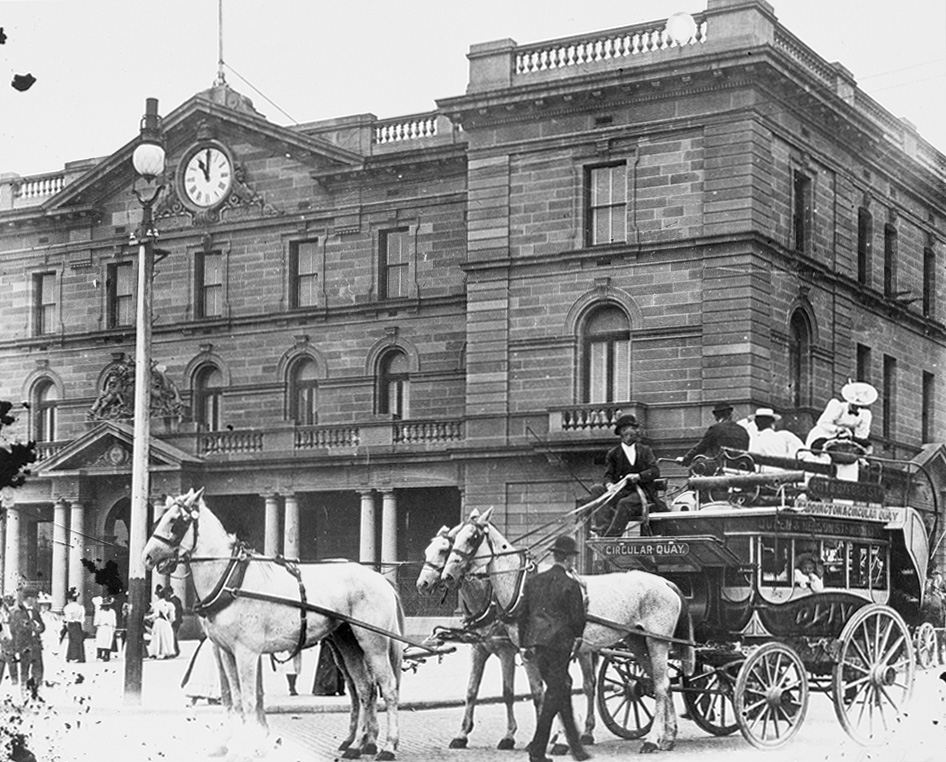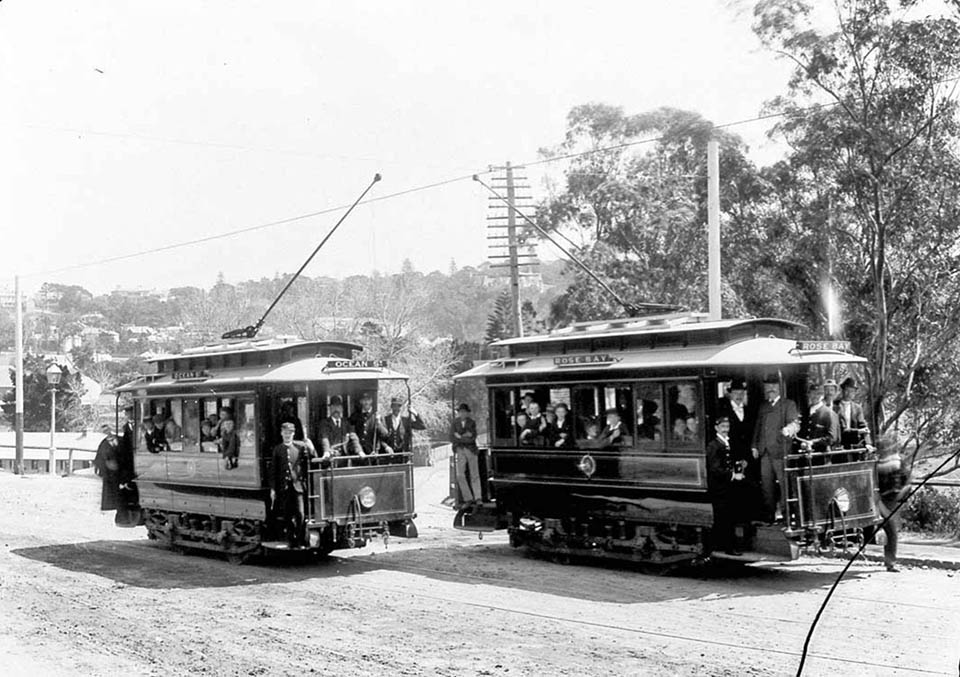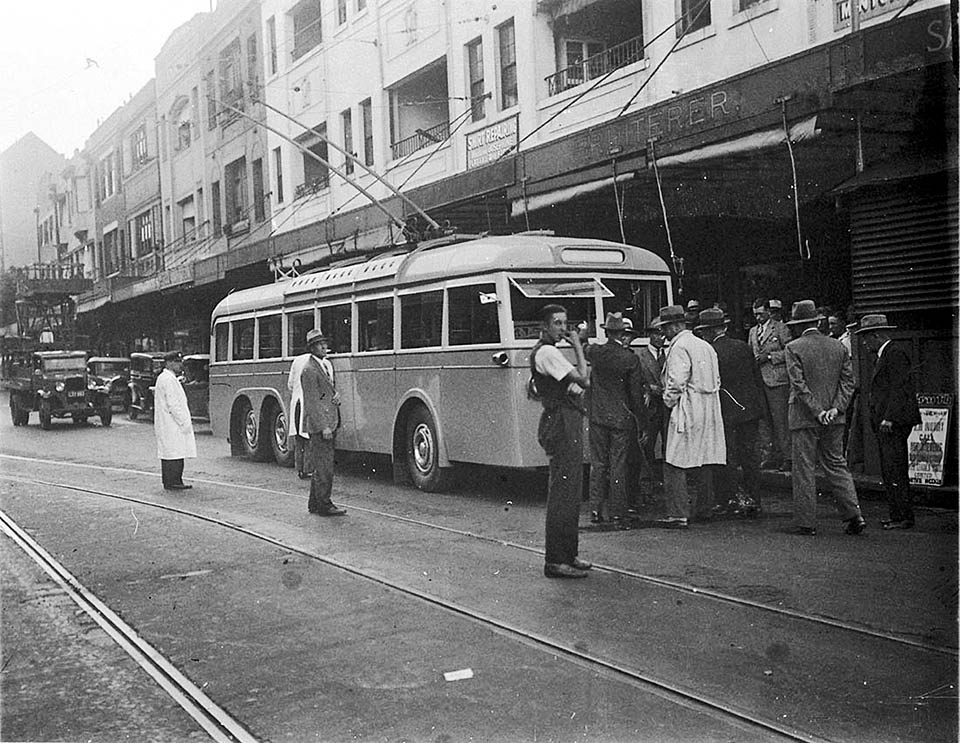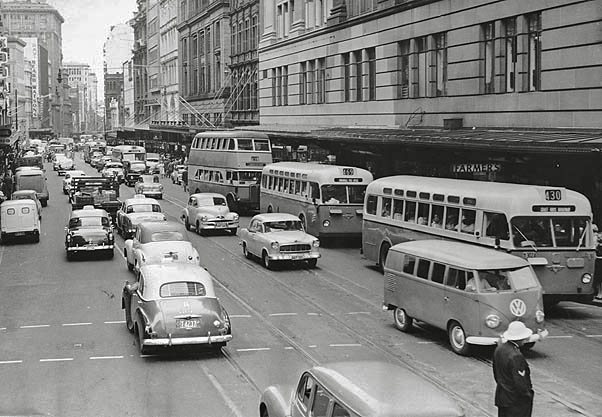The Dictionary of Sydney was archived in 2021.
Buses
Citation
Persistent URL for this entry
To cite this entry in text
To cite this entry in a Wikipedia footnote citation
To cite this entry as a Wikipedia External link
Buses
Anyone who has ridden around Sydney in the roofless double-decker tourist bus on a warm summer evening might be forgiven for thinking that this is how a city's transport should operate.
The views are far better than if one was travelling in either the current single-decker bus or on a train speeding through the suburbs with views of backyards, factories, shopfronts or freeway ramps. Instead, high up above the rest of the traffic, one could catch glimpses of far-away beaches or the harbour, or appreciate the vistas from hills or down picturesque gullies. [media]In the late nineteenth century, Sydney did have an extensive network of open-topped buses, drawn by horses and servicing its ever-expanding suburbs.
But realistically, Sydney's weather necessitated roofed buses, and the history of the city's buses is one of trade-offs between vision and possibilities, within the constraints of geography and demography, with new technologies creating opportunities, and problems.
[media]Sydney's initial publicly owned 'people-mover' was the Pitt Street tramway, using horse-drawn trams, which ran between Circular Quay and the railway terminus in the Cleveland Paddocks, and opened in December 1861, moving people up and down the spine of the city. But because of problems with the raised tram tracks and their impact on horses and wheeled carts, this tram was very unpopular, and a parliamentary committee recommended the closure of the tramline, which took place on 31 December 1866.
Horse-drawn buses
The tramway was immediately replaced by a privately owned, horse-drawn omnibus service, which remained Sydney's major form of urban transport until the early 1890s. [media]From the middle decades of the nineteenth century, new American technology in coach-building made possible rapid growth in production of coaches and buckboard buggies, and this had an impact on the sort of vehicles that could be used as Sydney's horse buses. Using new technologies, the early horse-bus system was quite extensive. Because horse buses did not require dedicated track and could use existing roads, they could more easily go into newly developing suburbs. In a rapidly expanding city like Sydney, horse buses were the low-cost option for transporting the spreading population.
The horse bus system reached its peak in 1889, when there were some 64 services in the greater Sydney area, of which 47 were licensed routes under the control of the city's Transit Commissioners. There was one service for the central business district, transporting passengers back and forth between Circular Quay and the railway terminus, then further from the city. [media]There were George Street services, which served both the inner and outer suburbs of the south, south-west, and west. Then there were the Pitt Street cross-city services, to both the inner and outer suburbs in the east. The other two main groups were the north shore services, and the suburban 'feeder' services.
At its peak, it provided Sydney with an extensive, if somewhat slow, land transport network, but by the early 1890s, the new, gradually implemented, tram service (now using steam or cable) was far more reliable, and it had started to drive almost all the competing longer distance buses off the road. [media]Traffic in the inner city resisted this trend, and inner-city and short-haul suburban horse bus services continued to grow and make a profit throughout the 1890s, whereas the equivalent tram services diminished. With electrification of the tramways, which began in 1890, trams started to make more gains.
By the early years of the twentieth century, when Sydney's tramway electrification was well under way and the aggressive development of an intensive service of inner-city tramways had begun, the horse buses were relegated to becoming feeders from those areas not served by trams.
Motor buses
[media]By the 1920s, Sydney had the second largest tramway system in the world, after London. But another new technology brought new challenges. The advent of the internal combustion engine saw the advent of the 'horseless buggy' – motorised vehicles, which eventually included buses. Entrepreneurs saw possibilities in this, and private bus companies emerged after World War I, competing with the publicly owned tramways. In Sydney in 1930, some 219 privately owned bus services provided transport for Sydneysiders, with approximately 612 private buses carrying 90 million passengers annually. But a year later, they faced competition from government buses when the new Department of Road Transport and Tramways was set up. The issue of competition between private and public ownership was critical in this period.
[media]In the interwar era, trolley-buses were introduced: a hybrid of bus and tram that did not require fixed tracks, although its motive power came from overhead wires. These had a wide coverage of the inner and middle ring of suburbs.
Buses versus trams
The issue of buses versus trams became a major transport concern from the 1930s, and was part of the process by which Sydney's trams, one of the largest and most efficient tram networks in the world, were gradually superseded in some of their routes by a revitalised railway network, and then replaced completely by buses. [media]In the late 1950s the decision was taken to remove trams from Sydney streets.
The inadequate public transport in the expanding frontiers of Sydney – mainly in the west, south-west and north-west, but also along the northern beaches – has meant that buses were, and still are, the most fundamental form of transport in these areas. The longest bus route in Sydney is from the city along the northern beaches to Palm Beach, a distance of 44 kilometres.
At the start of the twenty-first century, having buses as one of the major people-movers for Sydney still raises issues. While not requiring a dedicated track, buses have a major impact on roads, in terms of both space used (if there are dedicated lanes) and wear-and-tear, and increase road maintenance costs. Perhaps more importantly, the issues of climate change and planned reduction in carbon dioxide emissions are leading to consideration of new energy sources such as diesel, natural gas and electricity.
References
L Hovenden, 'Sydney's horse bus industry in 1889', in G Wotherspoon (ed), Sydney's Transport: Studies in Urban History, Hale & Iremonger in association with the Sydney History Group, Sydney, 1983
'75 years of buses: NSW Government Buses 1932–2007', Sydney Morning Herald, 3 December 2007










